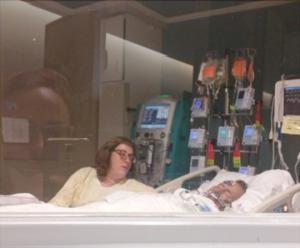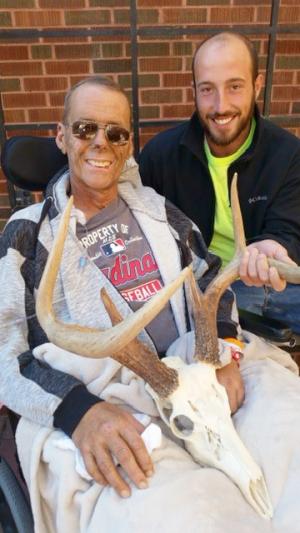The Weigand family of Warsaw, IL, lived a nightmare.
The nightmare had a name. Sepsis.

Travis Weigand
Sepsis is the body’s overwhelming response to infection. It can lead to tissue damage, organ failure, amputations and death. Sepsis kills 350,000 people each year in the U.S., 1 every 2 minutes; this is more than from prostate cancer, breast cancer, and opioid overdoses combined.
While sepsis did not kill Travis Weigand, it devastated his life and that of his family – wife Laura, daughter Cassie Grunewold and son Vincent.
Sepsis is sneaky
Travis was 58 years old when his life turned upside down in March 2016. A blood test he underwent to get life insurance showed colon cancer that had spread to his liver.
If that was not devastating enough, unknown to Travis and his caregivers six years ago, his body was missing a gene needed to metabolize a drug in the chemotherapy he was taking.
As a result of the missing gene, soon after he began chemotherapy Travis’s bone marrow stopped producing the white blood cells the immune system needs to fight infection. He went into what is called “septic shock” as infection raged through his body. Every organ shut down. Travis was placed in a medically-induced coma for eight days in an attempt to slow septic-related damage. Yet sepsis left its mark. Blood flow to Travis’s feet was impaired, leading to below-the-knee amputation on both legs.

Laura and Travis Weigand at the ICU
“They gave us a five percent chance of his survival,” said Laura, RN, BSN, CCRN, TNS, a long-time Blessing Hospital nurse. In spite of her education and experience, in 2016 Laura did not recognize what was happening to her beloved husband. Sepsis symptoms are sneaky and subtle. At the time she mistook them as to-be-expected side effects of chemotherapy.
“Terrifying,” is how Cassie described watching her father – a contractor by trade - suffer. “You watch this seemingly incredibly strong man waste away to practically nothing in a week’s time.”
“Hearing my mom have a discussion with the doctors on whether or not to keep him on life support was probably one of the most difficult things I’ve ever listened to in my life,” she added.
But this incredibly strong man fought his way back, at a cost. When Travis came out of the coma, he had lost 40 pounds and had complications in addition to his feet having been amputated.
“He couldn’t move when he woke up,” Laura said. “He couldn’t raise his hands. He could not lift his head up off the pillow. Travis needed weeks of rehabilitative care.”
To survive sepsis, Travis was hospitalized from the end of October until mid-December 2016.

Travis and son Vince outside of hospital
Travis did what few others are able. He survived sepsis and thrived for six more years.
“He experienced a lot in the years that followed, including becoming a grandfather twice,” Cassie said. “He lived a lot of life after that (sepsis). But it was an incredibly scary experience.”

Travis Weigand fishing after Sepsis recovery
Travis passed away on April 19, 2022, at the age of 62, as a result of colon cancer.
A life and career dedicated to sepsis awareness
Laura recently accepted a new position within Blessing Health – Sepsis RN Coordinator. She leads a team working to enhance the health system’s ability to more quickly identify patients with sepsis and begin their treatment.
While she is an accountant by trade, Cassie also willingly shares her knowledge and experience in hopes of saving other families from the devastation of sepsis.
“The hardest part is identification of sepsis,” said Laura.
The national Sepsis Alliance breaks down symptoms to the acronym TIME. Here is what to look for:
Temperature: Abnormal body temperature
Infection: Signs of infection
Mental decline: Confusion, just not themselves.
Extremely ill
Those at highest risk for sepsis are people 50 years and older with a diagnosed infection, or suspected infection. The risk decreases when a person takes steps to prevent or treat infections as quickly as possible by staying current with vaccinations, practicing good hygiene, and seeking medical help when an infection is suspected.
The majority of patients develop sepsis before seeking medical care. For that reason, Laura stresses loved ones need to understand and watch for the sepsis warning signs listed above, because the patient will be too sick to realize what is happening.
Act quickly. Every hour treatment is delayed, the risk of death increases by 8 percent. Anyone suspecting sepsis is urged to go to the nearest emergency room immediately and be very clear about their concerns.
“When you come into the hospital you need to say, ‘I’m concerned I may have sepsis,’” Laura urged.
That’s the voice of experience.
For more information on sepsis click here or visit sepsis.org.
